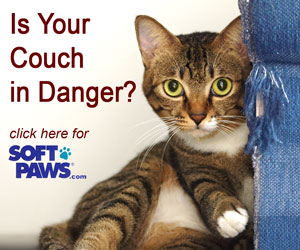Feline Vision
 You and your cat see the world differently. True, your eyes are built around the same design, but each of you has specializations that make your vision best for your needs. You evolved as a fruit-eating diurnal animal; your cat evolved as a meat-eating nocturnal animal. You evolved to have good detail and color vision; your cat evolved to have good vision in the dark. Compare your eye to your cat’s eye and you’ll understand how each of you attains the best vision for your needs.
You and your cat see the world differently. True, your eyes are built around the same design, but each of you has specializations that make your vision best for your needs. You evolved as a fruit-eating diurnal animal; your cat evolved as a meat-eating nocturnal animal. You evolved to have good detail and color vision; your cat evolved to have good vision in the dark. Compare your eye to your cat’s eye and you’ll understand how each of you attains the best vision for your needs.
The Pupil: Cat vs. Human
Light enters through the pupil, which gets larger or smaller to let more or less light in. The cat’s pupil can get much larger than your pupil can, letting in more light, but it does so at the expense of good depth of field (the distance over which objects can be put into clear focus).
When the cat’s pupil contracts, it doesn’t stay round, as a person’s does, but becomes a vertical slit. Slit pupils are seen in animals that are active in both day and night; their advantage is that they can cover a great range of sizes, getting much smaller, much faster, than can a round pupil. Their disadvantage is that when they are in their slit formation, they create optical interference that makes perfect focus difficult.
The Lens: Cat vs. Human
After passing through the pupil, light is collected and focused by the lens. A cat’s lens is much larger than a human's lens, which enables it to gather more light. But again, there’s a trade-off: while the small human lens can change shape to focus light over a great range of distances, the big cat lens can hardly change its shape at all. As a result, cats have difficulty focusing on objects very close to them, very much like an older person who needs reading glasses.
The Retina: Cat vs. Human
The optics of the eye work to focus an image on the retina, the lining at the back of the eye which is made up of cells that react to light. Several factors influence how fine the detail is that a retina can pick up. First, how well is the image focused upon the retina? If the lens is too strong for the distance between it and the retina, the image will come to a focus before it gets to the retina and will be de-focused by the time it reaches it. If the lens is too weak for the distance to the retina, the image will still be unfocused when it reaches it. In most cats, the lens strength is appropriate for the distance to the retina; that is, cats are neither nearsighted nor farsighted.
Second, the farther the distance to the retina and the larger the retina, the larger the image can be on the retina. Cats have large eyes and retinas for their size.
Third, the smaller the sampling grain on the retina, the better the ability to detect details. Both cats and people have two different types of receptors in their retinas, each with a different sampling grain. Rods pool light from comparatively large areas on the retina, while cones have a very fine sampling grain. Humans have a cone-rich retina, and even have an area in the center of the visual field made up of only cones. Cats have a rod-rich retina and no cone-only area.
Cones and Color Vision in Cats
The end result of all this is that cats have poor detail vision compared to humans. And because cones are also responsible for color vision, cats have comparatively poor color vision. But they’re not colorblind. Instead, they have the same type of color vision as many people who are called colorblind: a type of red-green colorblindness termed deuteranopia. They can see blue versus other color fine but tend to confuse colors on the red through brown through green continuum.
Cats See Better Than Humans in the Dark
Cats give up the ability to see fine detail and rich colors in exchange for the ability to see well in the dark. The level of retina illumination is about five times higher in your cat’s eye than in yours. And all those rods pooling signals from minute amounts of light allow the cat to pick up the faintest light source. Nonetheless, some light still manages to pass between the rods and cones. Instead of letting it be absorbed at the back of the eye, as the human eye does, the cat has a structure called the tapetum lucidum that reflects light back to the receptors for a second chance to create a signal. The eye shine you see when you shine a light at a cat in the dark is the reflected light that has managed to elude the receptors in both directions and is bouncing back to you from the tapetum. The end result is that cats can see light at eight times dimmer illumination than you can. Learn more here: "Night Vision in Cats."
In summary, the cat’s eye is specialized to see in dim and changing light, which serves them well during the twilight times of dusk and dawn, when they like to hunt. To achieve this, the cat's eye sacrifices the ability to focus close up, fine detail vision, and some color vision. It is the vision of a hunter active in both day and night, enabling it to detect movement under any lighting conditions, to use binocular vision to gauge distance, and to aim correctly to catch prey.
You May Also Like These Articles:
Why Do Some Cats Have Two Different Colored Eyes?
Why Do Some Cats Carry Food Out Of Their Bowls to Eat It?
Why Does My Cat Sleep on My Head?
Why Do Cats Knock Things Over?
Cats Have Personality Traits Similar to Humans
Cat Kneading: Why Do Cats Do It and What Do People Call It?
Notice: Ask-a-Vet is an affiliated service for those who wish to speak with a veterinary professional about their pet's specific condition. Initially, a bot will ask questions to determine the general nature of your concern. Then, you will be transferred to a human. There is a charge for the service if you choose to connect to a veterinarian. Ask-a-Vet is not manned by the staff or owners of CatHealth.com, and the advice given should not delay or replace a visit to your veterinarian.





